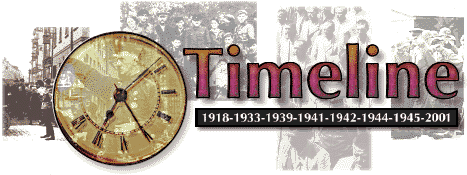
The Timeline section focuses on the history of the Holocaust, chronicling the years from 1918 to the present. Hitler's rise to power was the initiation of a period that wrought great fear and destruction. Millions were forced to live in ghettos, only to be deported later to the concentration camps. The tragic details remained obscure until the liberation of the death camps and the further revelations during the Nuremberg War Trials. The subsections below offer a simplified outline for thinking about how the Holocaust unfolded. However, it should be kept in mind that many of the categories overlap.
- Rise of the Nazi Party (1918-1933). During the fourteen years following the end of World War I, the Nazi party grew from a small political group to the most powerful party in Germany.
- Nazification (1933-1939). Once Hitler became Chancellor and later Reichsführer, the Nazi party quickly changed Germany's political, social, and economic structure.
- The Ghettos (1939-1941). Confining Jews to ghettos was another critical step in Hitler's Final Solution.
- The Camps (1941-1942). The concentration camps were Hitler's final step in the annihilation of the Jews.
- Resistance (1942-1944). People resisted by any means possible, from stealing a slice of bread to sabotaging Nazi installations.
- Rescue and Liberation (1944-1945). Some survived through the heroics of neighbors; others were liberated by the Allies.
- Aftermath (1945-2000). After the war, Nazi perpetrators faced punishment for their war crimes and survivors began rebuilding their lives.
A Teacher's Guide to the Holocaust
Produced by the Florida Center for Instructional Technology,
College of Education, University of South Florida © 2005.